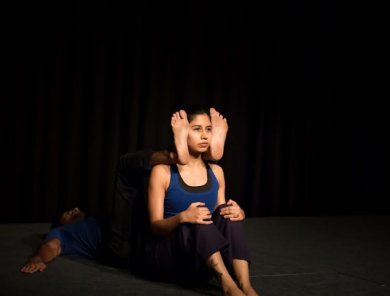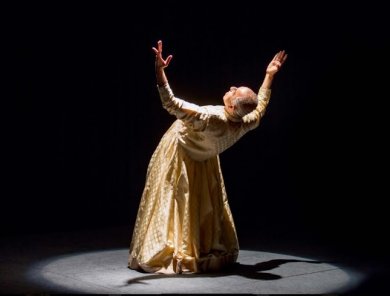
|   |

|   |
 e-mail: leelakaverivenkat@gmail.com Dance reflecting an approach not tethered to form Photos: Amit Kumar October 14, 2017 Black Box, G 54 Foundation for Contemporary Culture, a delightfully intimate space, with its convoluted address of 'Lakshmi Mills Estate, Shakti Mills Lane, Off Dr. E Moses Road, Mahalaxmi, Mumbai' is typical of the spaces within spaces this city specialises in. It was in the compact auditorium of 'Black Box' that the well-known magazine of the Arts, Marg had organised the release of its latest issue on Contemporary Dance in India on October 9, 2017. The word 'contemporary' is a loaded term and its connotation with respect to dance will always be contested, with classical dancers not willing to believe they are anything less than 'contemporary'. Contemporary Dance practitioners, however, for long have nursed a feeling of deprivation about their efforts not receiving the kind of government support their colleagues in the classical art forms get. After the formal release function followed a short but varied and arresting programme, which dancer Astad Deboo with his aesthetic refinement, had curated. The very opening item, a film, proved how Contemporary Dance, not tethered to any form, transcends cultural boundaries. Contemporary Vedas - The Dance Project, (PADAM) conceived by a young and enterprising Producer/Director/Choreographer Shreenath Muthyala, in a ten minute arresting film, demonstrated the moving power of a Kshetrayya Padam in Telugu, which becomes a perfect musical/interpretative base for a Western dance medium like Ballet. "Vegattayenee, payyada miida ceeri pavvalinci yundee saamiki" portrays the agonised separation pangs of the woman harking back to scenes of her past when her loved one, now indifferent, resting his head on the garment on her bosom, would keep feasting his eyes on her without blinking, even asking for a lamp in waning light so as to see her better! The warm tones of raga Nadanamakriya filled the space - rendered by singer Aruna Sairam with her rich voice, and the excellent music produced and composed by Ram Sampath created the emotive take-off point for the ballet dancer Eriko Sugmura, whose graceful body expressed the pain and longing of the song in full. It was a kind of angikaabhinaya wherein the body and its attitudes expressed emotion. Unlike the Japanese not known for wearing their hearts on their faces, Eriko has a uniquely mobile face and the blended movement/facial expression with the musical effects produced by supporting instruments, Western and Indian, playing around the Padam (of which only the Pallavi was sung) evoked the full impact of composer Kshetrayya's intent in this lyric. The other credits for the film comprise Sunny Bhardwaj (introductory music), Nirmish Gollamandala (title design) and Rasa Acharya Partin (cinematography). How expressions from different cultures can blend with conviction was proved for all to see.  Shamsul The puppet performance by Delhi puppeteer Shamsul followed. Balancing the puppet, his own creation, in front of his body (his head was behind in the dark as he manipulated the puppet), his feet lifted to be placed on either side of the puppet's face were like hands cupping the face. The puppeteer's hands working in front, as also his feet, as seen above, became extensions of the puppet. With its glassy blue-eyed, unblinking stare, head slowly turning from side to side, or a suddenly puckered annoyed face, or creased look with closed eyes, the puppet became a character taking on many shades of mood.  Avantika Bahl and Vishal Sarvaiya Then came two Mumbai based dancers of Contemporary Dance, Avantika Bahl and her partner Vishal Nagin Sarvaiya (who is hearing-impaired and interacts through sign language). The total understanding between the dancers spoke of long practice. The weight balance and distribution, and immense movement possibilities between two bodies in contact, held audience captivated. Movement with no help from any other discipline (literature or music) communicated varying tones - now warm and loving and now confrontationist. Presenting a part of a longer work, the two dancers interacted in different ways. Sometimes isolated parts of the body - like the knee or just the feet created movement variety on their own and this was one of the aspects of the skilled technique of the two dancers - both excellent movers, interacting individually or in contact.  Astad Deboo The last hurrah belonged to dancer Astad Deboo projecting his typical style, body bending backwards in the most difficult positions, excellent body balance, minutely sensitive finger movements with hands in mudras, the eyebrow movements and of course that formidable ability for endless slow swirling and pirouetting with a sudden stop, all conveying a meditative, prayerful attitude, responding to the mixed music which is one of his strong points. His early training in Kathak and Kathakali on which was superimposed training in some Western Contemporary Dance techniques, have all contributed to Astad's own individualistic approach to movement in dance. One could see the endless possibilities in creating movement, in the approach of each performer. 'Short and sweet' best describes the programme.  Writing on the dance scene for the last forty years, Leela Venkataraman's incisive comments on performances of all dance forms, participation in dance discussions both in India and abroad, and as a regular contributor to Hindu Friday Review, journals like Sruti and Nartanam, makes her voice respected for its balanced critiquing. She is the author of several books like Indian Classical dance: Tradition in Transition, Classical Dance in India and Indian Classical dance: The Renaissance and Beyond. Post your comments Please provide your name and email id when you use the Anonymous profile in the blog to post a comment. All appropriate comments posted with name & email id in the blog will also be featured in the site. |